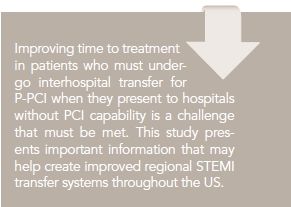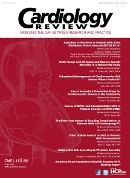Publication
Article
Cardiology Review® Online
Causes of Delay and Associated Mortality in Patients Transferred With STEMI
Author(s):

Eric R. Bates, MD
REVIEW

Eric R. Bates, MD review Miedema MD, Newell MC, Duval S, et al. Causes of delay and associated mortality in patients transferred with ST-segment-elevation myocardial infarction. Circulation. 2011;124:1636-1644.
T
otal ischemic time is the most important determinant of clinical outcome in patients with ST-elevation myocardial infarction (STEMI) treated with reperfusion therapy. Measuring the door-to-balloon time has been successfully used to reduce in-hospital system delays for primary percutaneous coronary intervention (P-PCI). In the United States, over 90% of direct-admit patients not excluded for extenuating clinical circumstances are now treated at PCI centers with door-to-balloon times within 90 minutes, the treatment goal established by clinical guidelines1 and performance measures.2 This represents a major improvement in treatment delays that were documented only a few years ago.3 The next challenge in reperfusion therapy is improving time to treatment in patients presenting to hospitals without PCI capability who must undergo interhospital transfer for P-PCI.
The recently released American College of Cardiology Foundation/American Heart Association/Society for Cardiovascular Angiography and Interventions (ACCF/AHA/SCAI) PCI Guidelines again endorse P-PCI as the preferred reperfusion strategy, with a P-PCI goal of 90 minutes for first-medical-contact-to-balloon time at hospitals that have PCI capability.1 Note that the concept of “first medical contact” is meant to encourage the use of the prehospital ECG to make the STEMI diagnosis earlier and start the system response to STEMI before the patient reaches the door of the emergency department (ED). This metric is also meant to be a hospital-quality metric measured over the course of a year, to be used to identify logistical delays that prolong time to treatment. It is not meant to be used to make treatment decisions on whether P-PCI or fibrinolytic therapy should be chosen as the reperfusion strategy for an individual patient.
It is important to recognize the challenges that prolong door-to-balloon times in patients presenting to hospitals without PCI capability and the superiority of P-PCI as a treatment option when treatment delays are minimized. Nevertheless, the goal for first-medical-contact to-balloon time for interhospital transfer patients has recently been increased from 90 to 120 minutes.1 The aim is to encourage hospitals to develop more efficient regional STEMI systems rather than to discourage them by challenging them with an unrealistic treatment goal. It is not meant to erode the gains that have been made in the in-hospital system of care by pulling back from the 90-minute target for direct admits to PCI centers, but rather to promote a more organized prehospital system of care to increase patient access to P-PCI.
Study Details
Miedema et al report on the frequency, magnitude, and clinical impact of specific delays in their superb regional system designed for the rapid transfer of STEMI patients for P-PCI from 31 referral hospitals. Their study population included 2034 patients treated between March 2003 and December 2009. The goal was to achieve a referral hospital door-indoor- out (DIDO) time within 45 minutes, an interhospital transfer time within 45 minutes, and a PCI center door-to-balloon time within 30 minutes, for a total hospital door-to-balloon time within 120 minutes.
The study included 11 hospitals within 60 miles of the PCI center and 20 hospitals 60 to 120 miles away. The diagnosis was made by the ED physician; a single phone call activated the system. Standardized protocols and a predetermined transfer plan were established at each site. Patients bypassed the PCI center ED and were directly admitted to the cardiac catheterization laboratory for P-PCI.
The most common reasons for delay at the referral hospital were delays awaiting transport and ED delays. DIDO times greater than 45 minutes occurred in 64% of referral hospitals. The longest ED delays occurred in patients with nondiagnostic initial ECGs or investigations for diagnoses other than STEMI. Transport delays were noted in 12.6% of transfers due to weather or distance, but were not associated with increased mortality risk. Delays at the PCI center (15.7% of patients) were most commonly due to catheterization laboratory team delays and complex procedures.
Older patients and nonsmokers, and those with diabetes or cardiogenic shock, had the longest delays. As expected, patients with cardiogenic shock and/or cardiac arrest had the highest mortality rates. The overall in-hospital mortality rate was 5.4% and the 1-year mortality rate was 9.9%. Compared with patients treated within 120 minutes, patients treated later than within 120 minutes had increased hospital mortality (6.4% vs 4.1%; P = 0.023) and a trend for increased 1-year mortality (10.2% vs 8.8%; P = 0.29).
References
1. Levine G, Bates ER, Blankenship JC, et al. 2011 ACCF/AHA/SCAI Guideline for Percutaneous Coronary Intervention. J Am Coll Cardiol. doi:10.1016/j.jacc.2011.08.007. http: //content.onlinejacc.org/cgi/content/full/j. jacc.2011.08.007. Published 2011. Accessed November 16, 2011.
2. Krumholz HM, Anderson JL, Bachelder BL, et al. ACC/AHA 2008 performance measures for adults with ST-elevation and non-ST-elevation myocardial infarction. A report of the American College of Cardiology/American Heart Association Task Force on Performance Measures (Writing Committee to develop performance measures for ST-elevation and non- ST-elevation myocardial infarction): developed in collaboration with the American Academy of Family Physicians and the American College of Emergency Physicians: endorsed by the American Association of Cardiovascular and Pulmonary Rehabilitation, Society for Cardiovascular Angiography and Interventions, and Society of Hospital Medicine. Circulation. 2008;118:2596-2648.
3. Krumholz HM, Bradley EH, Nallamothu BK, et al. A campaign to improve timeliness of primary percutaneous coronary intervention: Door-to-Balloon: An Alliance for Quality. JACC Cardiovasc Interv. 2008;1:97-104.
4. Nallamothu BK, Bates ER, Herrin J, et al. Times to treatment in transfer patients undergoing primary percutaneous coronary intervention in the United States: National Registry of Myocardial Infarction (NRMI)-3/4 analysis. Circulation. 2005;111:761-767.
5. American Heart Association. Mission: Lifeline. http://www.heart.org/HEARTORG/ HealthcareResearch/MissionLifeline- HomePage/Mission-Lifeline-Home-Page_ UCM_305495_SubHomePage.jsp. Accessed November 17, 2011.
COMMENTARY
Meeting the Challenge of Tomely STEMI Transfer
T
his study presents the first description of the frequency and magnitude of treatment delays in a regional STEMI system of transfer for P-PCI. Several years ago, only 4% of transfer patients were treated within 90 minutes and only 16% were treated within 120 minutes.4 With great emphasis on decreasing logistical delays in time to treatment, these investigators were able to treat 30% of patients within 90 minutes and 66% within 120 minutes, an impressive accomplishment given some long-distance transfers. The results for the transfers within 60 miles were even more impressive: 43% treated within 90 minutes and 79% treated within 120 minutes. Longer delays were measured with transport distances 60 to 120 miles: 12% treated with 90 minutes and 47% treated within 120 minutes.
Nevertheless, treatment delays still occurred frequently, most commonly at the referral hospital. The authors suggest that delays awaiting transport may be reduced by establishing standard transfer protocols and increasing the availability of transport vehicles. ED delays may be improved with continued clinical systems improvement and feedback/quality improvement with a DIDO goal of 30 minutes when there are no delays in awaiting arrival of the ambulance or helicopter.
The ideal transfer strategy for patients with STEMI is direct transport to a PCI center, bypassing hospitals without PCI capability, with prehospital diagnosis and notification of the cardiac catheterization laboratory. However, only 50% of patients use emergency medical services and some of them are required to transport to the nearest hospital. Therefore, all hospitals without PCI capability need to develop and participate in a regional STEMI transfer system to increase timely access to P-PCI. The results of this report demonstrate that median referral hospital door-to-balloon times within 120 minutes should be obtainable for hospitals without PCI capability in urban or suburban locations. Whereas many rural hospitals may also be able to achieve these treatment goals, others will need to adopt fibrinolytic therapy as the initial reperfusion strategy, with a door-toneedle goal within 30 minutes if they cannot consistently meet the P-PCI target. Current guidelines encourage transfer of patients receiving fibrinolytic therapy to PCI centers so that coronary angiography with intent to perform PCI can be accomplished within 24 hours of symptom onset.1 Developing an excellent regional STEMI transfer system can be achieved through participation in the AHA’s Mission: Lifeline program.5
About the Author
Eric R. Bates, MD, is professor of internal medicine at the University of Michigan. Dr Bates graduated from the University of Michigan Medical School, where he trained in internal medicine and cardiology. He is vice-chair for the 2011 ACCF/AHA Guideline for Percutaneous Coronary Intervention Writing Committee, and chair for the program committee of the American Heart Association Council on Clinical Cardiology. He is also chair of the Mission: Lifeline Science Task Force.
